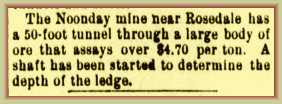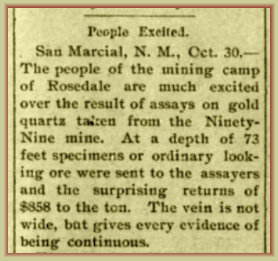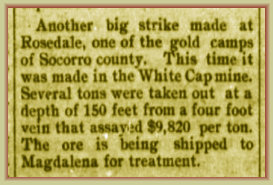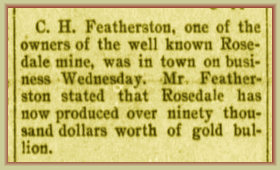On this page:
The Lane Prospects were located in Whitecap canyon in early 1895, the canyon about two miles north of the Rosedale mine. Typical to
most all Rosedale Mining District claims, traces of gold were found in surface rhyolite outcroppings suggesting subterranean
veins. Several
prospects were worked in the canyon, all operating under the name of the Whitecap mine and for a time under
the name of the New Mexico Mining Co. This mining operation was likely the 3rd leading gold producer in the region
over its history, though exact production numbers are not known.
Initially, the mine consisted of surface work, pits and trenches
to recover the gold ore, and exploratory adits to find the vein. The first newspaper mention was October 1895 reporting a carload
of ore was shipped out of Magdalena for the Colorado Iron Works in Denver for smelting. This first shipment must have yielded good
gold as the new mine was quickly described in the Santa Fe New Mexican:
"The White Cap mine is in the Rosedale
district, owned by J.W.
Richardson, the discoverer, James Kellar, Chas. Featherston and
the Harry Gray estate, has been bonded to C.W. Barr & Co. ...
$1,200 will be advanced, the
whole of which is to be spent in
development work. At the end of six months, if the company
is
satisfied with the outlook, the sum of $16,000 will be paid for the
property.
Mining men say that the mine gives promise of being a
valuable property."
By 1898, the Whitecap mine
was an expanding enterprise. The initial investors sold their interests with the new owners listed as San Marcial merchants
J.E. Nichols and C.H. Featherston, along with a party of Pittsburg capitalists.
Charles H. Featherston was the former supervisor
of the Rosedale mine and apparently replaced by a new management team when the mine was purchased by the Martin Co. in 1898.
Featherston obviously moved on to become a principal in the Whitecap mine.
Featherston reported to the Santa Fe New Mexicanin December the mine is operating two claims over 20 acres and has $75,000 worth of ore blocked out waiting to be mined and shipped.
Considerable machinery is also waiting at the San Marcial freight house and "will be transported to the mine as soon as the snow
leaves the ground." He also reports over 800 feet of a shafts, tunnels and drifts following the eight foot wide vein, which
is producing $10–$12 per ton peppered with rich pockets. One such rich pocket was sent to the smelter at Kelly which produced
an impressive $1,200 per ton return.
The June 30, 1900 Socorro Chieftain had the following glowing report. $9,820
per ton is an astounding yield by any measure.
$90,000 of gold bullion (about $2.7 million today) is a respectable yield and clearly placed the enterprise into profitable gold.
By 1902, the Whitecap mine reported the main shaft was down 243 feet with 50 feet of drifting on either side of the shaft along the
vein with the ore averaging $14 per ton with the occasional rich pocket enhancing their profits. The mine also began work on
a new nearby claim, now giving the Whitecap mines three working claims.
The mine continued to operate as evidenced by periodic newspaper
articles of their ongoing operations, although lacking in details with no production figures cited for this period.
A report in the New Mexico School of Mines, Bulletin No. 2, a report of all Socorro County active mines, indicated the mine was still
active and operating in 1918 with the following brief description:
"The Lane prospect is about 2 miles north
of Rosedale in Whitecap
canyon not far east of Whitecap spring. The vein is well defined and
strikes northwest. It is very similar in many respects to the Rosedale
vein. The ore is said to
be richer than at Rosedale."
The Last Days. Like most of the mines in the Rosedale region, little news appears in local
newspapers after about 1920 as many of the area mines began to close. It is presumed this included the Whitecap mine.
In 1927, a party of prospectors did some development work at the Golden Bell and Whitecap mines, though no followup news is found
to indicate any ore shipments were made. The last mention of the Whitecap mine was in 1932 – a small attempt to recover some
paying ore during the Great Depression, though no shipment or production numbers are known, if indeed any profitable gold was mined.
The Whitecap mine appears to have closed in early 1920s with the two brief episodes in 1927 and 1932. The mines have been abandoned
since.
33.8397N, -107.4078W Elev. 7,39 ft. ASL
The Robb Prospects were located south and southwest of the Rosedale mine and on the same vein, literally walking distance from the
Rosedale mill. The claim was developed by J.H. Robb beginning in 1899 and involved a small hill or prominence of rhyolite, the
same vein as the Rosedale mine. The vein was about ten feet wide.
In 1900, Robb developed three claims called the Noonday,
Gray Horse and Spikeback. Only the Noonday was developed to produce modest quantities of gold ore. On June 6, 1900 theSanta Fe New Mexican reported:
33.8050°N, -107.4067°CW Elev. 7,198 ft. ASL
In 1900, the Ninety-Nine mine was owned by J. Harry, James Conner, W. Greenwood, I. Rosebrook and Charles Watlington. The vein
was followed by a shaft and drifts. In May 1901, the Socorro Chieftain reported that Louis Lockhart was awarded a
$500 contract to sink the main shaft another 100 feet showing the rapid pace of expansion.
Like most of the other mines in the
region, there is no known documentation on shipments, production, or profits made by the mine. By 1905, the Ninety-Nine
mine seemed to be idle as stated in this annual Report of the Governor of New Mexico:
"Thus far the Rosedale has
been the only producer, other properties
being the New Golden Bell, White Cap, Bay Horse, Ninety-one,
May Dew, Baking Powder, New Year, New Year No. 1, Rockefeller,
Golden Gate,Gold Cap, Amy B., Greenwood, and Graham."
However, a brief newspaper article indicated the Ninety-Nine mine was again producing
gold ore with ongoing developmental work in 1907. The mine operated intermittently into the 1920s. In 1927,
a newspaper account reported ore assayed from the Ninety-Nine mine at $12 per ton at the bottom of a recently completed 2-foot winze.
This is the last mention of the mine.
The Ninety-Nine mine did seem to have mined some rich ore, at least at times, with periods
of impressive profits. Unfortunately there are no known company records to reveal the success of this mine or any details of
its history.
NOTE: Unlike other mines in Socorro County, there is very little specific
information available on the Rosedale area mine workings.
Much of the following is based on period newspapers reports and articles, primarily from the Socorro Chieftain and Santa Fe New Mexican newspapers.
Have photos? Rosedale photos are scarce!
If you have photos of the Rosedale mining district, the town, or of
family that worked the mines or lived in the area you'd like to share, please let us know here and we'll add them
to these archive pages with proper credit.
By the following year, the Feb. 9, 1901 Socorro Chieftain revealed some production numbers from the White Cap mine.
$4.70 per ton is hardly worth the effort and far below what is normally considered the break-even point, even for a small mine, though
to be expected at the initial stages of working a vein. The explorations continued and by 1902, the Noonday mine reported
the shaft was down 110 feet following the vein with ores assayed from $12 to $14 per ton for a measure of profit.
After 1902, there are few mentions of the mine workings, ore shipped, or amount of gold produced due to a lack of known
documentation. The next mention is in the 1918 mining report in the New Mexico School of Mines, Bulletin No. 2, which described
the operation.
"The Robb Prospect is on the claim that adjoins the Rosedale mine on
the
south. The vein at this place is 10 feet wide. Mr. Robb reports ore
valued at $12 a ton at the bottom
of a 20-foot winze. Fine-grained
volcanic breccia which carried considerable manganese is visible in
the bottom of this winze. The rhyolite at this prospect and especially
in the ridges between it
and Rosedale shows some flowage features
and contains feldspar phenocrysts in addition to the quartz.
The
Noonday mine likely ceased operations in the early 1920s when many of the other area mines and prospects failed.
In addition
to Rosedale and the Whitecap canyon workings, prospectors also staked claims in Big Rosa canyon. Only the Nine-Nine and
Baking Powder mine had any level of production.


The Nine-Nine mine was a prospect that struck good gold in a hurry, taking the area by surprise as this Nov. 3, 1900 Socorro Chieftain article
shows:
Links:
Socorro County Historical Society
Socorro, New Mexico, USA
History
Articles
Rosedale and the Rosedale Mines
Mines3
5


Rosedale Area Mines
Click on mine name for more information
Mines3
19/0615



